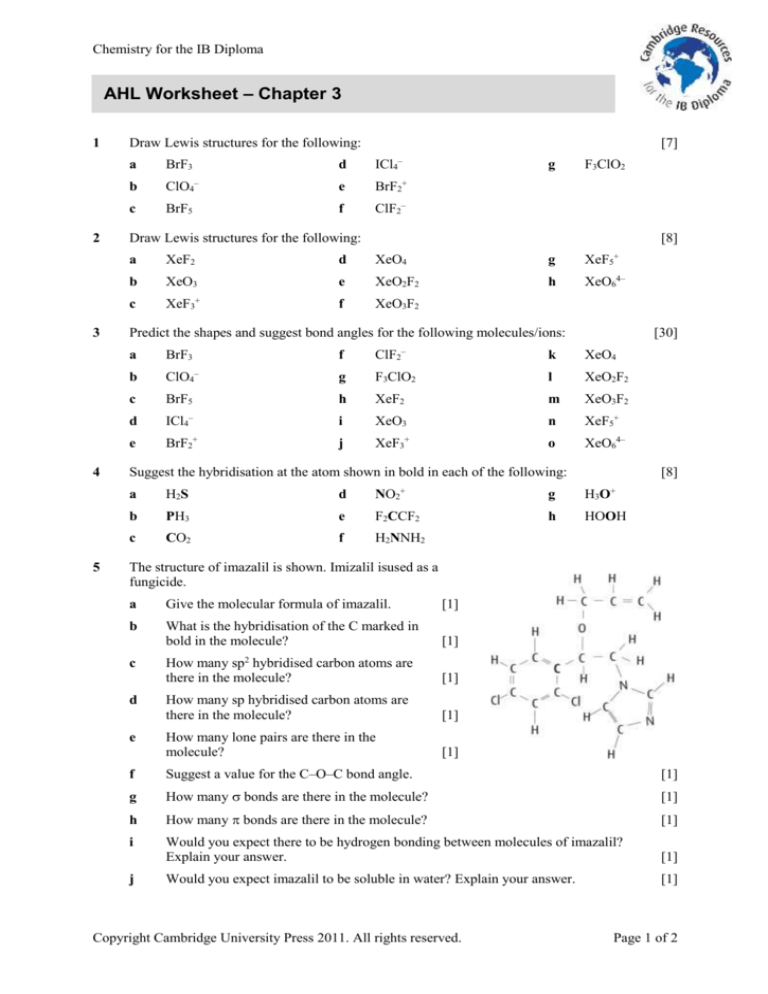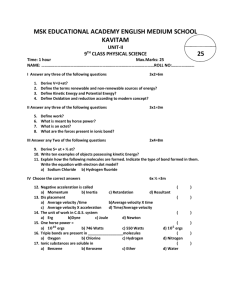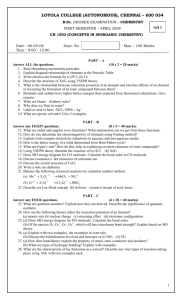
Chemistry for the IB Diploma
AHL Worksheet – Chapter 3
1
2
3
Draw Lewis structures for the following:
a
BrF3
d
ICl4
b
ClO4–
e
BrF2+
c
BrF5
f
ClF2–
5
g
F3ClO2
Draw Lewis structures for the following:
[8]
+
a
XeF2
d
XeO4
g
XeF5
b
XeO3
e
XeO2F2
h
XeO64–
c
XeF3+
f
XeO3F2
Predict the shapes and suggest bond angles for the following molecules/ions:
a
4
[7]
–
BrF3
–
[30]
f
ClF2–
k
XeO4
b
ClO4
g
F3ClO2
l
XeO2F2
c
BrF5
h
XeF2
m
XeO3F2
d
ICl4–
i
XeO3
n
XeF5+
e
BrF2+
j
XeF3+
o
XeO64–
Suggest the hybridisation at the atom shown in bold in each of the following:
[8]
a
H2S
d
NO2+
g
H3O+
b
PH3
e
F2CCF2
h
HOOH
c
CO2
f
H2NNH2
The structure of imazalil is shown. Imizalil isused as a
fungicide.
a
Give the molecular formula of imazalil.
[1]
b
What is the hybridisation of the C marked in
bold in the molecule?
[1]
How many sp2 hybridised carbon atoms are
there in the molecule?
[1]
How many sp hybridised carbon atoms are
there in the molecule?
[1]
How many lone pairs are there in the
molecule?
[1]
c
d
e
f
Suggest a value for the C–O–C bond angle.
[1]
g
How many bonds are there in the molecule?
[1]
h
How many bonds are there in the molecule?
[1]
i
Would you expect there to be hydrogen bonding between molecules of imazalil?
Explain your answer.
[1]
Would you expect imazalil to be soluble in water? Explain your answer.
[1]
j
Copyright Cambridge University Press 2011. All rights reserved.
Page 1 of 2
Chemistry for the IB Diploma
6
Draw a diagram showing the and bonding in a molecule of ethene, C2H4.
[2]
7
a
Give the formula of the carbonate ion.
[1]
b
Draw a Lewis structure for the carbonate ion.
c
Some C–O bond lengths are given in the following table:
[1]
Bond length / nm
d
8
C–O
0.143
C=O
0.122
CO
0.113
Explain why all the C–O bond lengths are equal in the carbonate ion and suggest a
value for the C–O bond length in the carbonate ion.
[3]
Suggest the C–O bond order in the carbonate ion.
[1]
Predict and explain which of the two molecules below will have the higher melting point.
Copyright Cambridge University Press 2011. All rights reserved.
[4]
Page 2 of 2









